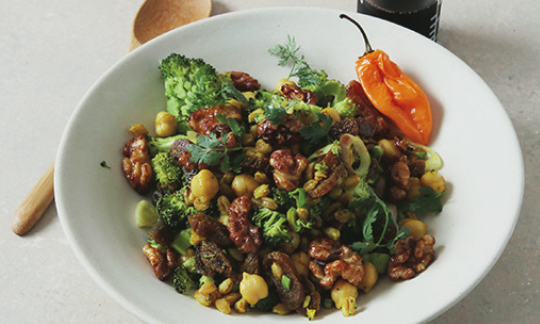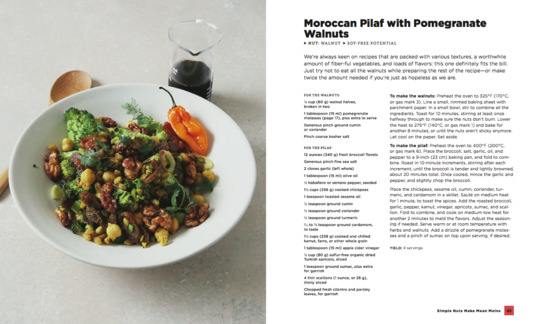Moroccan Pilaf with Pomegranate, Walnuts, and Chickpeas
vegan
Ingredients (for servings, )
| For the walnuts | |
|---|---|
| 2 ⅛ oz | Walnuts (tree nuts), raw (organic?) |
| 1 tbsp | Pomegranate syrup (organic?) (0.53 oz) |
| 1 dash | Cumin, ground (raw, organic?) (0.00 oz) |
| 1 dash | Salt, table salt (0.01 oz) |
| For the pilaf | |
| 12 oz | Broccoli, raw (brocoli, broccoli, brokoli, asparagus cabbage) |
| ½ | Chili peppers, red, raw (organic?) (0.09 oz) |
| 1 dash | Salt, table salt (0.01 oz) |
| 2 cloves | Garlic (organic?) (0.21 oz) |
| 1 tbsp | Olive oil (cold pressed, raw?, organic?) (0.47 oz) |
| 2 ¾ oz | Apricots, dried, unsulphured (raw?, organic?) |
| ⅞ oz | Spring / leek / winter onions, raw, organic? |
| 8 ⅔ oz | Cooked chickpeas (organic?) |
| 1 tsp | Sesame oil, roasted (organic?) (0.16 oz) |
| ½ tsp | Cumin, ground (raw, organic?) (0.05 oz) |
| ½ tsp | Coriander, seeds (raw?, organic?) (0.03 oz) |
| ½ tsp | Turmeric, fresh (raw, organic?) (0.04 oz) |
| ⅛ tsp, ground | Cardamom (Cardamom, Kardamon, Kardamum) (0.01 oz) |
| 9 ½ oz | Kamut or Khorasan wheat, cooked (organic?) |
| 1 tbsp | Apple cider vinegar (raw?, organic?) (0.52 oz) |
| 1 tsp | Gerber Sumac, raw (Sumak, organic?) (0.12 oz) |
| Garnish | |
| 2 tbsp | Coriander leaves, raw (0.05 oz) |
Equipment
- baking pan (springform pan)
- skillet (frying pan)
- stove
- oven
- baking sheet (cookie sheet)
Type of preparation
- bake
- chop or grind
- sauté
- dry roast
Preparation
To make the walnuts
Preheat the oven to 325 °F (170 °C or gas mark 3). Line a small, rimmed baking sheet with parchment paper. In a small bowl, stir to combine all the ingredients. Toast for 10 minutes, stirring at least once halfway through to make sure the nuts don’t burn.In the original recipe, the authors use pomegranate molasses instead of pomegranate syrup (here and in Step 8).
Lower the heat to 275 °F (140 °C or gas mark 1) and bake for another 8 minutes, or until the nuts aren’t sticky anymore. Let cool on the paper. Set aside.
To make the pilaf
Preheat the oven to 400 °F (200 °C or gas mark 6). Wash the broccoli and cut into florets. Deseed the chili pepper.The authors suggests using habañero or serrano peppers.
Place the broccoli, salt, garlic, oil, and pepper in a 9-inch (23 cm) baking pan, and fold to combine. Roast in 10-minute increments, stirring after each increment, until the broccoli is tender and lightly browned, about 20 minutes total.
Once cooled, mince the garlic and pepper, and slightly chop the broccoli.
Finely slice the apricots and scallions and set to the side. Place the chickpeas, sesame oil, cumin, coriander, turmeric, and cardamom (all spices ground) in a skillet. Sauté on medium heat for 1 minute, to toast the spices.
Add the roasted broccoli, garlic, chili pepper, kamut, vinegar, sliced apricots, sumac, and thinly sliced scallions. Fold to combine, and cook on medium-low heat for another 2 minutes to meld the flavors. Adjust the seasoning if needed.
Serving
Serve warm or at room temperature with herbs and walnuts. Add a drizzle of pomegranate syrup and a pinch of sumac on top upon serving, if desired.The authors suggest using chopped fresh cilantro and parsley leaves for garnish.
|
Nutritional Information per person
Convert per 100g
|
2000 kcal | |
|---|---|---|
| Energy | 404 kcal | 20.2% |
| Fat/Lipids | 17 g | 23.7% |
| Saturated Fats | 1.8 g | 8.9% |
| Carbohydrates (inc.dietary fiber) | 58 g | 21.6% |
| Sugars | 16 g | 18.3% |
| Fiber | 15 g | 58.7% |
| Protein/Albumin | 15 g | 30.4% |
| Cooking Salt (Na:121.5 mg) | 309 mg | 12.9% |
| Essential micronutrients with the highest proportions | per person | 2000 kcal | |
|---|---|---|---|
| Vit | Vitamin K | 106 µg | 141.0% |
| Min | Manganese, Mn | 2.1 mg | 106.0% |
| Vit | Vitamin C (ascorbic acid) | 80 mg | 100.0% |
| Fat | Alpha-Linolenic acid; ALA; 18:3 omega-3 | 1.4 g | 72.0% |
| Fat | Linoleic acid; LA; 18:2 omega-6 | 7.0 g | 70.0% |
| Min | Copper, Cu | 0.67 mg | 67.0% |
| Vit | Folate, as the active form of folic acid (née vitamin B9 and | 124 µg | 62.0% |
| Prot | Tryptophan (Trp, W) | 0.15 g | 59.0% |
| Prot | Threonine (Thr, T) | 0.53 g | 57.0% |
| Prot | Isoleucine (Ile, I) | 0.66 g | 53.0% |
Detailed Nutritional Information per Person for this Recipe
The majority of the nutritional information comes from the USDA (US Department of Agriculture). This means that the information for natural products is often incomplete or only given within broader categories, whereas in most cases products made from these have more complete information displayed.
If we take flaxseed, for example, the important essential amino acid ALA (omega-3) is only included in an overarching category whereas for flaxseed oil ALA is listed specifically. In time, we will be able to change this, but it will require a lot of work. An “i” appears behind ingredients that have been adjusted and an explanation appears when you hover over this symbol.
For Erb Muesli, the original calculations resulted in 48 % of the daily requirement of ALA — but with the correction, we see that the muesli actually covers >100 % of the necessary recommendation for the omega-3 fatty acid ALA. Our goal is to eventually be able to compare the nutritional value of our recipes with those that are used in conventional western lifestyles.
| Essential fatty acids | per person | 2000 kcal |
|---|---|---|
| Alpha-Linolenic acid; ALA; 18:3 omega-3 | 1.4 g | 72.0% |
| Linoleic acid; LA; 18:2 omega-6 | 7.0 g | 70.0% |
| Essential amino acids | per person | 2000 kcal |
|---|---|---|
| Tryptophan (Trp, W) | 0.15 g | 59.0% |
| Threonine (Thr, T) | 0.53 g | 57.0% |
| Isoleucine (Ile, I) | 0.66 g | 53.0% |
| Phenylalanine (Phe, F) | 0.71 g | 46.0% |
| Leucine (Leu, L) | 1.0 g | 43.0% |
| Valine (Val, V) | 0.70 g | 43.0% |
| Lysine (Lys, K) | 0.72 g | 38.0% |
| Methionine (Met, M) | 0.20 g | 22.0% |
| Vitamins | per person | 2000 kcal |
|---|---|---|
| Vitamin K | 106 µg | 141.0% |
| Vitamin C (ascorbic acid) | 80 mg | 100.0% |
| Folate, as the active form of folic acid (née vitamin B9 and | 124 µg | 62.0% |
| Vitamin B6 (pyridoxine) | 0.45 mg | 32.0% |
| Thiamine (vitamin B1) | 0.28 mg | 26.0% |
| Vitamin E, as a-TEs | 3.1 mg | 26.0% |
| Niacin (née vitamin B3) | 4.0 mg | 25.0% |
| Biotin (ex vitamin B7, H) | 9.2 µg | 18.0% |
| Riboflavin (vitamin B2) | 0.21 mg | 15.0% |
| Pantothenic acid (vitamin B5) | 0.92 mg | 15.0% |
| Vitamin A, as RAE | 77 µg | 10.0% |
| Essential macroelements (macronutrients) | per person | 2000 kcal |
|---|---|---|
| Phosphorus, P | 335 mg | 48.0% |
| Potassium, K | 903 mg | 45.0% |
| Magnesium, Mg | 123 mg | 33.0% |
| Calcium, Ca | 117 mg | 15.0% |
| Sodium, Na | 122 mg | 15.0% |
| Essential trace elements (micronutrients) | per person | 2000 kcal |
|---|---|---|
| Manganese, Mn | 2.1 mg | 106.0% |
| Copper, Cu | 0.67 mg | 67.0% |
| Selenium, Se | 24 µg | 44.0% |
| Iron, Fe | 5.0 mg | 36.0% |
| Zinc, Zn | 3.1 mg | 31.0% |
| Iod, I (Jod, J) | 20 µg | 13.0% |
| Fluorine, F | 11 µg | < 0.1% |
Spices like cumin and sumac give this Moroccan Pilaf with Pomegranate, Walnuts, and Chickpeas its delicious Asian flavor.
Nutritional profile: This dish contains high levels of vitamin K. According to GDA guidelines, one serving of this recipe also covers the recommended daily requirement for vitamin C and manganese. The ratio of omega-6 to omega-3 fatty acids does not exceed the maximum recommended ratio of 5:1. Further information can be found at the following link: A Vegan Diet Can Be Unhealthy. Nutrition Mistakes.
Walnuts: English walnuts (also called Persian walnuts or Circassian walnuts, Juglans regia) are the most common type of walnut in Central Europe. Walnuts are the nuts that have the highest content of alpha-linolenic acid (ALA). They are also rich in tocopherols, a group of four different forms of vitamin E, as well as many macroelements and trace elements.
Pomegranate syrup: Pomegranate syrup is an alcohol-free, sugar-sweetened fruit syrup that has a deep red color and is used in cocktails for flavor and to add color. When you are purchasing this product, make sure that it is authentic pomegranate syrup and not grenadine syrup.
Kamut: Kamut or Khorasan wheat is one of the oldest grains and related to the wheat we have today. The kernels of this ancient grain are almost twice as large as those of conventional wheat and more yellow in color.
Chickpeas: With an average of 20 g protein per 100 g, chickpeas are very high in protein and therefore a good addition to vegetables. Chickpeas (like many other legumes) are usually available in stores either dried or precooked (canned). While the canned version is of course more convenient and time-efficient, dried chickpeas that you cook yourself have a much better taste. And when you cook them at home, you can decide how firm you want them to be (canned chickpeas are often very soft, sometimes even mushy). In addition, canned foods often contain unnecessary additives or are already salted. It is therefore best to use the unprocessed version whenever possible.
Sumac: Sumac is a typical Arabic or oriental spice and is actually called Sicilian sumac, tanner’s sumach, or elm-leaved sumach. The spice is dried and usually sold in ground form. The tart dark red spice is often mixed with salt and is particularly popular in Turkish, Arabic, Kurdish, and Persian cuisine.
Cumin: As they have a similar name in many languages (e.g., in German: Kreuzkümmel and Kümmel), cumin and caraway are often confused. However, they actually aren’t closely related and have a very different flavor. Cumin is often used in Indian, Turkish, and Greek cuisine.
Cooking kamut: It’s best to let the kamut soak in water overnight before cooking it the next day. Make sure to pour off the soaking water and use new water to cook it in.
Buying canned chickpeas: If you are going to use the quick variety, as the author suggests here, then make sure to buy organic chickpeas. These are often processed more gently, and most importantly they usually contain very few or no additives at all. It is better to buy organic chickpeas in glass jars (organic brands often choose glass jars). These do not contain any aluminium or BPA (bisphenol A) and are more environmentally friendly.
Making your own pomegranate syrup: If you would like to make your own pomegranate syrup, we would recommend trying out of these recipes:
– Pomegranate Syrup
– Pomegranate Syrup with Orange and Vanilla Flavor





